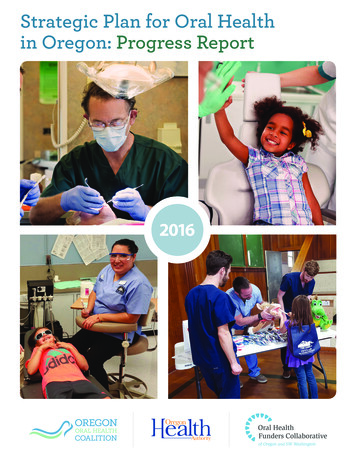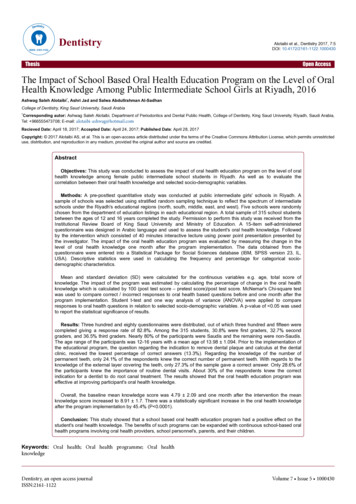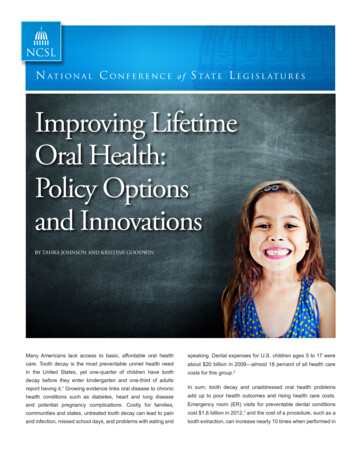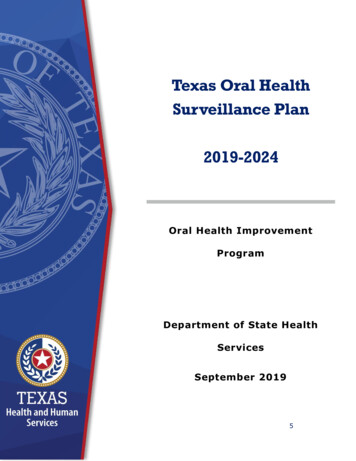
Transcription
Strategic Plan for Oral Healthin Oregon: Progress Report2016OREGONORAL HEALTHCOALITIONImproving general health through oral healthfor all Oregonians
ENDORSEMENTSTABLE OF CONTENTSThe stakeholders listed below haveendorsed the recommendations inthe Strategic Plan for Oral Health inOregon: 2014-2020.STRATEGIC PLAN OVERVIEW1EXECUTIVE SUMMARY2 Advantage Dental AllCare Health Benton, Linn, Lincoln RegionalOral Health Coalition of Oregon Cambia Health Foundation Capitol Dental Care, Inc. CareOregon CareOregon Dental Central Oregon Oral HealthCoalition Columbia Pacific CCO Dental Foundation of Oregon Health Share of Oregon Jackson Care Connect Kaiser Permanente Moda Health/Delta Dental ofOregon/ODS Multnomah County HealthDepartment Northwest Health Foundation Oral Health FundersCollaborative of Oregon andSouthwest Washington Oregon Child DevelopmentCoalition The Oregon CommunityFoundation Oregon Dental Association Oregon Dental Hygienists’Association Oregon Governor’s Office Oregon Health & ScienceUniversity and OHSU Schoolof Dentistry Oregon Health Authority Oregon Oral Health Coalition Oregon Primary Care Association Permanente Dental Associates Providence Health & Services Samaritan Health Services Upstream Public Health Virginia Garcia MemorialHealth Center Yamhill CCO Yamhill County Public HealthPriority Area 1: Infrastructure . 2Priority Area 2: Prevention and Systems of Care . 3Priority Area 3: Workforce Capacity . 3ORAL HEALTH IN OREGON4Plan History . 4PRIORITY AREA 1: INFRASTRUCTURE5Summary . 5Action at the State Level . 5Legislative Action on Oral Health Since 2014 . 6Coordinated Care Organizations (CCOs) . 6Building Coalitions . 7Building Capacity . 7Health System Integration . 7Data Collection and Access . 8PRIORITY AREA 2: PREVENTION & SYSTEMS OF CARE9Summary . 9Water Fluoridation . 9Maternal Oral Health . 9Infants and Children . 9Patients with Special Needs .11Underserved and High-Risk Adults .11Expanding Oral Health Literacy .12PRIORITY AREA 3: WORKFORCE CAPACITY14Summary .14Workforce Shortages .14Pilot Projects for Workforce Development .14Cultural Competence and Diversity .15Community-Based Rotations .16Teledentistry and Mobile Services .16Expanded Practice Dental Hygienists (EPDHs) .17SELECTED REFERENCES18
OFFICE OF THE DIRECTORKate Brown, GovernorNovember 10, 2016Dear Oregonians,500 Summer St NE E20Salem OR 97301Voice: 503-947-2340Fax: vOral health is an essential component of overall health; it is fundamental to our wellbeing, productivity and quality of life. To reduce the social and economic cost of oraldiseases and related illnesses, it is essential for all Oregonians to receive timely andequitable dental care throughout every stage of life.In 2013, the Oregon Oral Health Coalition, the Oral Health Funders Collaborative andOregon Health Authority came together with almost 200 oral health advocates toproduce the Strategic Plan for Oral Health in Oregon: 2014-2020. This plan has servedas an inspiration and guide for coordinated care organizations (CCOs), local oral healthcoalitions and other organizations around the state.Thanks to the exceptional energy and commitment of Oregon’s oral health advocates,our state has made progress toward the goals outlined in the Strategic Plan. However,there is more work to do. I commend the achievements we have made to date andbelieve we have built a strong foundation for future success. I strongly support continuedefforts to improve oral health care integration as a key component of overall health forall Oregonians.Everyone who cares about the health of our state should take the time to review thisprogress report, which outlines Oregon’s record of success and innovation as well as thework that remains to be done to ensure that Oregonians of all ages receive timely,affordable and appropriate oral health care and preventive services.Sincerely,Lynne SaxtonDirector
CONTRIBUTORSThis biennial progress report is based on interviews with 50 diverse stakeholders — including care providers, insurance providers,public health experts, funders and state leaders — all of whom generously shared their time, knowledge and expertise to document thecurrent state of oral health care in Oregon. This report was funded by the Oral Health Funders Collaborative, a partnership of 13 regionalgrantmakers who are coordinating their efforts to identify and invest in lasting oral health solutions for Oregon and Southwest Washington.John Adams, MAJenna Harms, MPHConor McNulty, CAEGary Allen, DMD, MSChuck Haynie, MDLaura McKeane, EFDAMohamed Alyajouri, MPHLaurie Huffman, MS, LPCJoAnn Miller, MSElizabeth Aughney, DDSLynn Ironside, RDHAmanda Peden, MPHBruce Austin, DMD, LMTLaurie Johnson, DMSc, MA, RDHKaren Phillips, RDHTeri Barichello, DMDMolly JohnsonCatherine Potter, MAPaul Bollinger, MPHSusan KirchoffMel Rader, MSLisa Bozzetti, DDSRichie Kohli, BDS, MSSuk Rhee, MAGeralyn Brennan, MPHSarah Kowalski, RDHEli Schwarz, DDS, MPH, PhDEastern Oregon Healthy Living AllianceAdvantage DentalOregon Primary Care AssociationOne Community HealthOregon Health AuthorityModa HealthHealth Share of OregonVirginia Garcia Memorial Health CenterOregon Health AuthoritySuzanne BrowningYamhill Community Care OrganizationWater Fluoridation AdvocateOregon School-Based Health AllianceOregon Dental Hygienists’ AssociationOregon Health AuthorityAdvantage DentalDental3OHSU School of DentistryOregon Health AuthorityOregon Dental AssociationAllCare HealthSamaritan Health ServicesOregon Health AuthorityDental3Kaiser PermanenteUpstream Public HealthNorthwest Health FoundationOHSU School of DentistryKemple Memorial Children’s Dental ClinicWater Fluoridation AdvocateGary Lahman, MT, MPHHeather Simmons, MPHTracy Dannen Grace, MBAAnnette LeongMatt Sinnott, MHASarah Dryfoos, BADeborah LoyDayna SteringerKurt Ferré, DDSSharity Ludwig, EPDH, MSMatt StillerTony Finch, MA, MPHLinda Mann, BS, EPDHRebecca Sweatman, MPHKaiser PermanenteOregon Primary Care AssociationCreston Children’s Dental ClinicOregon Oral Health CoalitionAlyssa Franzen, DMDConsultantCapitol Dental Care, Inc.Advantage DentalCapitol Dental Care, Inc.PacificSource Health PlansWillamette Dental GroupWestern Oregon Advanced HealthMedical Teams InternationalProvidence Health & ServicesCareOregonOHSU School of DentistryPhillip Marucha, DMD, PhDAmy Umphlett, MPHMelissa Freeman, MPHJill Mason, MPH, RDHCate Wilcox, MPHKaren Hall, EPDHShanie Mason, MPHMary Ann Wren, RDHKelly HansenRaji Mathew, DDSMolly YeendThe Oregon Community FoundationOregon Oral Health CoalitionOregon Health AuthorityOHSU School of DentistryConsultantCapitol Dental Care, Inc.Oregon Health AuthorityOregon Health AuthorityAdvantage DentalThe Oregon Community Foundation
STRATEGIC PLAN OVERVIEWPriority Area 1: InfrastructureOBJECTIVE 1OBJECTIVE 2Selected Outcome MeasuresOregon’s oral health infrastructuredelivers better care, better health andlower costs.Oregon’s oral health infrastructurereflects and supports health systemtransformation priorities.1. Oregon Health Authority (OHA)prioritizes oral health and providesleadership in state-level policy, fundingand regulatory discussions anddecisions.1. Coordinated care organizations (CCOs)comprehensively integrate oral health. Oregon has an appropriately staffed, funded andempowered dental director (2015). OHA develops a strategic plan to expand Oregon’soral health surveillance system (2015). Oregon has a reporting database that trackshospital emergency visits for nontraumatic dentalproblems (2017). Health information systems include detaileddata on race, ethnicity, language and othercharacteristics necessary to monitor oral healthequity as required by state law (2017). All school-based health centers and federallyqualified health centers integrate oral health careinto their activities (2018).2. OHA and its community partnersexpand and improve Oregon’s oralhealth surveillance system.3. Local and county oral healthinfrastructure facilitates equitable andtimely access to oral health prevention,education and care.2. Dental benefit packages align withpreventive goals and provide adequatecare to ensure optimal oral healthmaintenance and equitable outcomesacross the lifespan.3. Payment practices for dental servicesalign with current billing andreimbursement models and with theOregon Dental Practice Act.Priority Area 2: Prevention and Systems of CareOBJECTIVE 1OBJECTIVE 2Selected Outcome MeasuresEvidence-based prevention strategiesare implemented across everyOregonian’s lifespan.Oregonians achieve oral health literacyand understand that oral health isinseparable from overall health.1. Maintain or establish optimallyfluoridated community water systems.1. Develop a communications plan toeducate all Oregonians on oral health.2. Include oral disease prevention inprenatal and pediatric programs.2. Integrate oral health education intogeneral health education for all ages. Population residing in communities with optimallyfluoridated water Pregnant women who had their teeth cleanedwithin the previous year Children 0 to 5 with a dental visit in the previousyear Third graders with decay experience3. Expand access to screenings, fluoridetreatments and care for high-riskchildren. Children 6 to 9 with dental sealants on one or morepermanent molars Individuals who have received First Tooth training4. Expand evidence-based, best-practiceoral health programs in schools. Eighth graders with decay experience 11th graders with a dental visit in the previous year5. Provide community-based prevention,outreach, education and interventionto underserved adults and seniors. Adults 18 and older with a dental visit in theprevious year ED utilizations for nontraumatic dental problems6. Integrate oral health with chronicdisease prevention and management.Priority Area 3: Workforce CapacityOBJECTIVE 1OBJECTIVE 2Suggested Outcome MeasuresOregon has an adequate andequitable distribution of oral healthprofessionals.Oregon’s oral health workforce meetsthe lifelong oral health needs of allOregonians, including underservedand vulnerable populations. Number of expanded practice dental hygienists(EPDHs) practicing in Oregon communities. Source:Oregon Dental Hygienists' Association (ODHA). Number of dental students completing a 30-dayrural rotation. Source: Oregon Health & ScienceUniversity (OHSU). Proportion of underrepresented minority studentsadmitted to dental programs. Source: OHSU. Number of oral health care providers whocompleted cultural competency training asmandated by the Oregon Board of Dentistry.Source: OHA.1. Encourage oral health professionals towork at the top of their license.2. Train traditional health workers andrelated professionals to providebasic preventive care and to connectcommunity members with oral healthproviders.1. Foster a culturally competent oralhealth workforce.2. Equip providers with education andtechnology to enable them to reachunderserved patients.3. Incentivize providers to work in ruraland underserved areas.3. Emphasize public health philosophyand practice in dental healthprofessional curricula.4. Support pilot workforce projects madepossible by Senate Bill 738.4. Integrate oral health education into thecurricula for all health care providers.5. Encourage retired professionals toreturn to practice as insured volunteers.Strategic Plan for Oral Health in Oregon 2016 Progress Report1
EXECUTIVE SUMMARYAlthough a great deal of work remains to be done, the major accomplishments detailed in this progress reportshould be a source of pride and encouragement to everyone who is striving to improve oral health in our state.The Strategic Plan for Oral Health in Oregon reflects an expert consensus on effective methods for optimizing oral health in ourstate. It identifies three priority areas: Infrastructure, Prevention and Systems of Care and Workforce Capacity. This biennial progressreport assesses each area, highlighting Oregon’s remarkable record of success and innovation as well as the work that still needsto be done to meet the objectives set forth in the Strategic Plan.Priority Area 1: InfrastructureSince the Strategic Plan was published in 2014, Oregon has seen a concerted effort to build state, regional and local oral healthinfrastructure and capacity. Here are some key accomplishments: Oregon now has a state dental director, which has led to a new era of cross-divisional collaboration on oral health.The State Health Improvement Plan (SHIP) recognizes oral health as a statewide priority.Legislative actions have expanded dental access for Oregonians of all ages.Medicaid expansion has increased adult dental benefits to include dentures, denture replacement and stainless-steel crowns.Although Oregon has made substantial progress on all outcome measures, only one goal was completed on schedule: a reportingdatabase that tracks emergency department visits for nontraumatic dental problems.Priority Area 1: Outcome MeasuresTargetStatusOregon has an appropriately staffed, funded and empowered dental director per Association of State andTerritorial Dental Directors (ASTDD) best practices.2015In ProcessOregon Health Authority (OHA) develops a strategic plan to improve and expand oral health surveillance.2015In ProcessOHA’s oral health program is adequately funded to implement the activities outlined here and in the Public HealthDivision’s health improvement plan, and to meet ASTDD guidelines for state oral health programs.2016In ProcessOHA Metrics and Scoring Committee adopts comprehensive metrics for oral health.2016In ProcessOral health coordinators serve each county through public health departments, nonprofits and other entities.2016In ProcessCoordinated care organizations (CCOs) have comprehensively integrated oral health.2016In ProcessOregon’s Centers for Medicare & Medicaid Services oral health program resolves discrepancies in billing andreimbursement practices.2016In ProcessOregon has a reporting database that tracks hospital emergency visits for nontraumatic dental problems.2017CompletedHealth information systems include detailed data on race, ethnicity, language and other characteristics necessaryto monitor oral health equity as required by state law.2017In ProcessAll school-based health centers (SBHCs) integrate oral health care into their activities.2018In ProcessAll federally qualified health centers (FQHCs) integrate oral health care into their activities.2018In ProcessRecommendations Oregon’s fee-for-service dental reimbursement rates vary by CCO. Medicaid reimbursement rates and alternative paymentmodels should incentivize providers to serve Medicaid clients while also encouraging care coordination and oral healthintegration. CCOs and dental care organizations (DCOs) should take advantage of opportunities to align oral health priorities, agree on keyperformance and outcome measures, and share innovative practices. Oregon’s health care advocates and workforce should continue working to coordinate and expand data collection andinformation sharing across organizations and agencies. Poor integration of electronic health records is hampering dental-medical-behavioral care coordination. Full integrationshould be promoted and incentivized.2Strategic Plan for Oral Health in Oregon 2016 Progress Report
Priority Area 2: Prevention and Systems of CareSince 2014, Oregon’s oral health efforts have focused mainly on preventive care for pregnant women and children. Services forthis population include school-based sealant programs as well as screening and fluoride varnish programs in primary care settingsand other non-dental sites. In 2012, Pew Charitable Trusts gave Oregon a B grade for its state sealant program. In 2015, the statereceived an A-. Although fewer programs specifically target adolescents, adults and seniors, general access has increased throughinnovative models such as teledentistry and the co-location of dental services with medical and behavioral health services.The reporting of outcomes data varies by source; some numbers were not available by the time of publication. With the exceptionof water fluoridation, all outcome measures for which data were available as of 2016 show steady progress.Priority Area 2: Outcome ntChangePopulation residing in communities with optimally fluoridated water22.6%22.2%25%10% h-1.8% iPregnant women who had their teeth cleaned within the previous year53.2%58.3%58.5%10% h9.6% hIndividuals who have received First Tooth training3,0464,3988,000162% h44.3% hEighth graders with decay experience70.1%68.7%63.1%10% i2.0% i11th graders with a dental visit in the previous year74.5%74.9%81.2%10% h0.5% hAdults 18 and older with a dental visit in the previous year63.8%67.0%70.2%10% h5.0% hRecommendations Expand models of care for adolescents, seniors, people with special needs, people with chronic diseases, and homeless andundocumented residents. Foster engagement, inclusion and relationship building with advocates who serve specific communities of color and whounderstand their prevailing cultural attitudes, risk factors, trusted knowledge sources, and challenges relating to oral health. Sustain long-term communication and advocacy efforts for community water fluoridation, including the defense andmaintenance of existing water fluoridation systems. Cultivate health care professionals and other knowledgeable individuals as community water fluoridation advocates.Priority Area 3: Workforce CapacityLack of access to providers remains a major barrier to receiving care. Since 2014, the percentage of Oregonians living in a dentalhealth professional shortage area (HPSA) has risen from 24 to 31 percent. This is not simply due to a lack of providers; it also stemsfrom inequitable distribution, especially in rural areas. In response, significant efforts are being made to improve workforce capacity: SB 738 pilot projects are testing new models of care, such as training dental health aide therapists (DHATs) and placement ofinterim therapeutic restorations by dental hygienists. The number of expanded practice dental hygienists (EPDHs) in Oregon has risen from roughly 200 in 2013 to 633 in 2016. HB 2024 mandates that traditional health workers (THWs) undergo training as oral health navigators and educators. Oregon Health & Science University (OHSU) requires cultural competency training for all third-year dental students.The Strategic Plan suggested developing baselines for workforce capacity. As of 2016, only one baseline figure was available.Priority Area 2: Outcome MeasuresProportion of underrepresented minority students admitted to dental programsTotalSource26.3%OHSURecommendations All stakeholders should support efforts to attract and retain a culturally competent and diverse dental workforce. Oregon’s impending shortage of lab technicians and dental assistants should be addressed immediately. In the future,workforce assessments should happen well before shortages occur.Strategic Plan for Oral Health in Oregon 2016 Progress Report3
ORAL HEALTH IN OREGONOregon’s oral health status has improved significantly since 2014. However, too many Oregonians of allages and regions still lack access to timely, affordable and appropriate dental care and preventive services.In 2014, the Strategic Plan for Oral Health in Oregon identifiedthree priority areas for optimizing statewide oral health:Oral Health and Well-Being in Oregon Infrastructure28% of adults avoid smiling dueto the condition of their teeth Prevention and Systems of Care Workforce CapacityThis biennial progress report for 2016 assesses the current stateof oral health care in each priority area, highlighting our state’sremarkable record of success and innovation as well as work thatstill needs to be done. It is based on input from 50 stakeholdersrepresenting a wide variety of public and private organizations,all of whom generously shared their time, expertise, knowledgeand concerns.Our report finds that state health system transformation andnational health care reform have done much to increase accessto oral health care and education in Oregon. Innovative projectshave sprung up around the state to improve the timeliness,quality, affordability and accessibility of care. Projects nowunderway range from advanced approaches like teledentistry toprograms that build on proven interventions such as parentingeducation. These efforts have succeeded through tireless workon the part of government leaders, policy experts and dentalprofessionals, but also through the dedication and vision ofresidents, activists and volunteers who want the best for theirchildren and their communities.The exceptional diversity, energy and commitment of Oregon’soral health advocates are major strengths. Nevertheless, moststakeholders agree that we still lack a shared, overarching visionthat can harness our state’s extraordinary vitality and facilitatecoordination at every level of our health system. In areas wherevision and leadership are lacking, constructive efforts occur inrelative isolation and important collaborative opportunities areoverlooked. When this happens, it is usually the most vulnerableOregonians who suffer the most serious health consequences.The inherent difficulty of working across agencies, fields anddisciplines is part of the problem. Further obstacles arise from anongoing lack of relevant data. The Strategic Plan identified datacollection and sharing as crucial to health system transformationin general and to oral health in particular. Although real progresshas been made statewide and in specific communities, thegoal of timely information sharing — including the integrationof electronic medical and dental health records — remainselusive. To achieve a truly holistic health care system that meetsthe medical, dental and behavioral needs of our increasinglydiverse population, Oregon’s health care advocates, experts andworkforce must have timely access to accurate data.Although a great deal of work remains to be done, the majoraccomplishments detailed in this progress report should be a4Strategic Plan for Oral Health in Oregon 2016 Progress Report20% of adults feel embarrassmentdue to the condition of theirmouth and teeth23% of adults feel anxiety dueto the condition of their mouthand teethChart adapted from Oral Health and Well-Being in Oregon. American DentalAssociation, Health Policy Institute, 2016. Used by permission.source of pride and encouragement to everyone who is strivingto improve oral health in our state. We hope that the StrategicPlan will continue to inspire and guide these efforts.Plan HistoryIn 2013, the Oral Health Funders Collaborative of Oregon andSouthwest Washington partnered with Oregon Health Authorityand the Oregon Oral Health Coalition to produce the StrategicPlan for Oral Health in Oregon. Almost 200 oral health advocatesrepresenting a wide variety of professional fields, communitiesand viewpoints took part in this collaborative process. Thepurpose of the Strategic Plan was to guide policymakers, funders,local coalitions and other motivated stakeholders as they worktogether to improve Oregon’s oral health system through 2020.Participants in the development of this plan followed threebasic guidelines:1. Teach Oregonians and policymakers that oral health isinseparable from overall health.2. Seek diverse perspectives, ranging from communitymembers to oral health professionals.3. Identify currently actionable community-basedstrategies that will improve oral health for allOregonians.Periodically, the Oral Health Funders Collaborative will sponsorprogress reports on the Strategic Plan, which will be shared at theOregon Oral Health Coalition’s annual conference. We welcomeyour comments, updates and suggestions.
PRIORITY AREA 1: INFRASTRUCTUREInfrastructure comprises all of the interconnected elements of the systems that provide oral healthservices to Oregonians, including resources, partnerships, and physical and organizational structures.SummarySince the Strategic Plan was published in 2014, Oregon hasseen a concerted effort to build state, regional and local oralhealth infrastructure and capacity. State actions include hiringa state dental director, improving internal collaboration acrossagency divisions, and launching an environmental scan of oralhealth integration. The State Health Improvement Plan (SHIP)has recognized oral health as a priority, and legislative actionshave expanded dental access for children and adults.Over the last two years, organizations around the state havecreated their own oral health plans, many of which align withthe Strategic Plan. To foster internal and external collaboration,Oregon Health Authority (OHA) is also developing an oral healthplan that will align with both the SHIP and the Strategic Plan.Pediatric dental benefits are now offered on the insurancemarketplace through the Affordable Care Act. In addition toreducing the population of uninsured Oregonians, Medicaidexpansion is advancing the coordination of medical, dental andbehavioral health care in our state. However, Oregon’s Medicaidreimbursement rates for fee-for-service dental care vary byCCO. The American Dental Association’s Health Policy Instituteemphasizes that “states that have implemented reimbursementincreases have seen significant gains in provider participationand access to dental care.”Coordinated care organizations (CCOs) are making progresstoward fully integrating oral health, and two incentive metricsfor oral health have been established. CCOs have recognized oralhealth as a priority, and some are accordingly supporting localor regional oral health initiatives. Current and emerging oralhealth coalitions are contributing valuable community input tothese efforts. At the same time, federally qualified health centers(FQHCs) and school-based health centers (SBHCs) have addedor expanded dental services in many communities.Despite Oregon’s many successes, there is an ongoing needfor shared priorities, clarity of roles, open communication, andcoordination between CCOs, dental care organizations (DCOs),community advisory councils, coalitions and other stakeholders.In particular, DCOs face challenges due to a lack of consistentexpectations, priorities and metrics.Action at the State LevelWhile the hiring of Dr. Bruce Austin as the state dental director(see below) is perhaps the most well known state action on oralhealth, many other important steps have been taken: Oral health is one of seven priorities in the SHIP. Plannedstrategies include population interventions, such asincreasing the number of fluoridated public water districts;health equity interventions, such as providing sealantsSPOTLIGHT ON SUCCESSIn 2014, the Strategic Plan noted Oregon’s need for a state dental director. In 2015, Senate Bill 672 establishedthe office of dental director by statute within Oregon Health Authority (OHA), and Dr. Bruce Austin wasappointed to this vital position. As part of OHA’s integrated Clinical Leadership Team, Dr. Austin coordinatesoral health activities across the Health Systems, Public Health, and Health Policy divisions. This has improvedcollaboration and awareness while further integrating oral health with physical and behavioral health systems.To build on this progress, a new cross-divisional Oral Health Team meets monthly. “It’s been rewarding tosee the vastly increased awareness of oral health across the state system,” Dr. Austin says.Dr. Austin has more than 30 years’ experience as a clinical dentist. During his first year as dental director, he met with oral healthadvocates and stakeholders to build relationships and learn firsthand about their needs. As of 2016, successes include integratingoral health into the State Health Improvement Plan (SHIP), issuing new recommendations to increase dent
In 2013, the Oregon Oral Health Coalition, the Oral Health Funders Collaborative and Oregon Health Authority came together with almost 200 oral health advocates to produce the Strategic Plan for Oral Health in Oregon: 2014-2020. This plan has served as an inspiration and guide for coordinated care organizations (CCOs), local oral health










